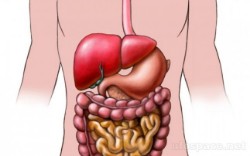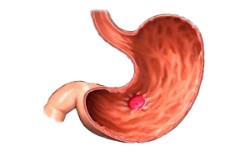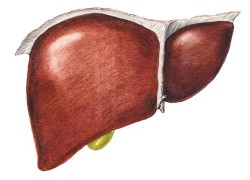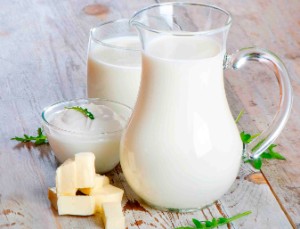Is cottage cheese useful for the liver — 3 facts, as well as possible harm
 The liver is one of the most efficient organs of our body, performing about 70 different tasks. The most important of them are cleansing the body of unnecessary substances and the production of bile necessary for digestion.
The liver is one of the most efficient organs of our body, performing about 70 different tasks. The most important of them are cleansing the body of unnecessary substances and the production of bile necessary for digestion.
It is quite natural that this tireless "worker" deserves to be "pampered" with healthy foods. Cottage cheese is considered to be one of them.
Exactly what properties of this product are useful for the liver, whether it is possible to use cottage cheese in food for diseases such as hepatosis and cirrhosis, as well as whether there are any other restrictions in its use, will be discussed in our article.
Content
3 useful properties
The composition of cottage cheese contains "methionine" &8212; a very important amino acid that is not produced independently inside our body. It is she who is the best friend of the liver.
1. Assistance in the implementation of fat metabolism
 Methionine has a valuable ability to dissolve fats, in the breakdown of which the liver plays a key role in our body.
Methionine has a valuable ability to dissolve fats, in the breakdown of which the liver plays a key role in our body.
The amino acid helps the liver in solving several tasks:
- Firstly, it prevents excessive fat deposition inside the organ, leading to its pathological changes.
- Secondly, methionine helps the liver to process fats from all over the body, contributing to the normal production of bile and the elimination of harmful excess cholesterol. This allows you to avoid diseases of the biliary tract, digestive system, Cardiovascular systems.
Thus, cottage cheese prevents liver obesity.
2. Cleansing and protecting the liver
 Methionine contained in cottage cheese has high antioxidant properties.
Methionine contained in cottage cheese has high antioxidant properties.
This allows it to fight dangerous free radicals and toxins, protecting cells from destruction.
Thanks to such a useful function, the amino acid does an excellent job of protecting the liver from harmful substances.
3. Improving the functioning of the gastrointestinal tract
Cottage cheese has no fibrous structure, its protein and nutrients are easily absorbed by the digestive system, without "burdening" it and without irritating the mucous membrane. It improves digestion, enhances intestinal motility and has a beneficial effect on its microflora.
 It is not surprising that this fermented milk product is actively used for constipation, is included in the diet for diseases of the stomach, pancreas, intestines.
It is not surprising that this fermented milk product is actively used for constipation, is included in the diet for diseases of the stomach, pancreas, intestines.
Cottage cheese can help with heartburn, unpleasant sensations after eating spicy food.
However, constantly eating a low-fat product is also not worth it. Its composition is no longer so rich in useful substances. The best choice would be a fermented milk product with 5% fat content.
Possible harm
Any properties of this fermented milk product that can harm a healthy liver are not known today. However, it is not necessary to overuse its types with high fat content. In some cases, with improper use, cottage cheese can do more harm than good, exacerbating the symptoms of some diseases of the gastrointestinal tract.
 Not recommended:
Not recommended:
- Raw cottage cheese – in the acute stage of gastritis. In this case, it is better to eat it processed – for example, by cooking a casserole, cheesecakes or souffle.
- Low–fat - for constipation. Due to its solid consistency, it can, on the contrary, exacerbate the problem. It is better to use low-fat cottage cheese, mixing it with sour cream.
Is it possible to have cottage cheese with a sick liver?
Cottage cheese is strongly recommended for use in liver diseases. However, with some restrictions – nutrition, saturating with the necessary nutrients, should not "load" the diseased organ at the same time. As a rule, in such cases, the mandatory requirements for this product are its freshness and low fat content (no more than 5%).
For hepatosis
 Hepatosis is a liver disease characterized by disorders of the structure of its cells and metabolism in them, resulting in the development of organ dystrophy.
Hepatosis is a liver disease characterized by disorders of the structure of its cells and metabolism in them, resulting in the development of organ dystrophy.
With fatty hepatosis, the cells of the organ accumulate an excessive amount of fat, which leads to the gradual replacement of healthy fatty tissue. The most common causes of its occurrence include the abuse of cholesterol-rich foods or, conversely, excessive dieting, as well as alcoholism and toxic poisoning.
This process is reversible and is subject to therapy. However, the disease is dangerous because, if left untreated, it can develop into cirrhosis.
The main task of the diet prescribed for this disease is to restore proper fat metabolism. At the same time, high-fat cottage cheese should be discarded - it should not exceed 5%.
Recipe for cheesecakes in the oven
Necessary products:
- Low–fat cottage cheese - 250 g.;
- Egg – 1 pc.;
- Flour – 1 tbsp. l.;
- Semolina – 2 tbsp. l.;
- Sugar – 1 tbsp. l.;
- Baking powder – half tsp. l.
Cooking process: grind cottage cheese with sugar and egg, add flour with baking powder and semolina, mix everything well. Leave for 15 minutes. Form the cheesecakes and place them on a baking sheet covered with baking paper in a preheated oven. Cook for 30 minutes. at 180°.
For cirrhosis
Cirrhosis is a chronic inflammatory disease of the liver in which its healthy active cells (hepatocytes) are gradually replaced by connective tissue. As a rule, the disease is a consequence of viral hepatitis (B, C) or alcoholism. The end result of this process is the organ's refusal to perform its functions.
Cirrhosis is very dangerous to human life and cannot be completely cured. However, timely therapy can stop the progression of the disease.
Nutrition in cirrhosis should promote the restoration of the cells of the diseased organ and prevent the further development of pathology without loading the digestive organs.
It is recommended to include low-fat non-acidic cottage cheese in the diet in its pureed natural form, and also use it in the preparation of various dishes – casseroles, puddings, lazy dumplings.
Recipe for cottage cheese and berry casserole
Necessary products:
- Low–fat cottage cheese – 300 g.;
- Non–acidic berries – 200 g.;
- Chicken egg – 1 pc.;
- Semolina - 2 tbsp. l.;
- Soda - half tsp. l.;
- Low–fat sour cream – 1 tbsp. l .
Cooking process: beat the egg, add cottage cheese, semolina, soda - mix everything. Add the berries there very carefully. Put the resulting mixture into a mold, grease the top with sour cream. Bake for 30 minutes. in the oven at 180-200 °.
Contraindications
Despite the overall high usefulness of cottage cheese, there are a number of common contraindications for its use:
- Personal intolerance. People with allergies to milk protein, unfortunately, will have to give up this product.
- Kidney diseases. In this case, it is better to limit its consumption. The fact is that due to the high protein content, it significantly loads the organs of the excretory system.
- Atherosclerosis, obesity. In this case, you should not get carried away with cottage cheese with a high fat content.
- Product stale. As a rule, the shelf life of natural cottage cheese is 72 hours. Therefore, when buying, it is worth carefully checking the date of manufacture, since the use of an expired product is fraught with food poisoning.
Recommended daily intake:
- For adults – no more than 200 g.;
- For children under one year of age – no more than 20 g.;
- For children over 1 year of age – no more than 60-100 g.
Interesting video
We recommend watching this video:
;
Conclusion
In general, cottage cheese must be present on the dining table of people of all ages. At the same time, it should be remembered that for liver health it is better to choose a natural product, without admixtures of various preservatives and flavors.





